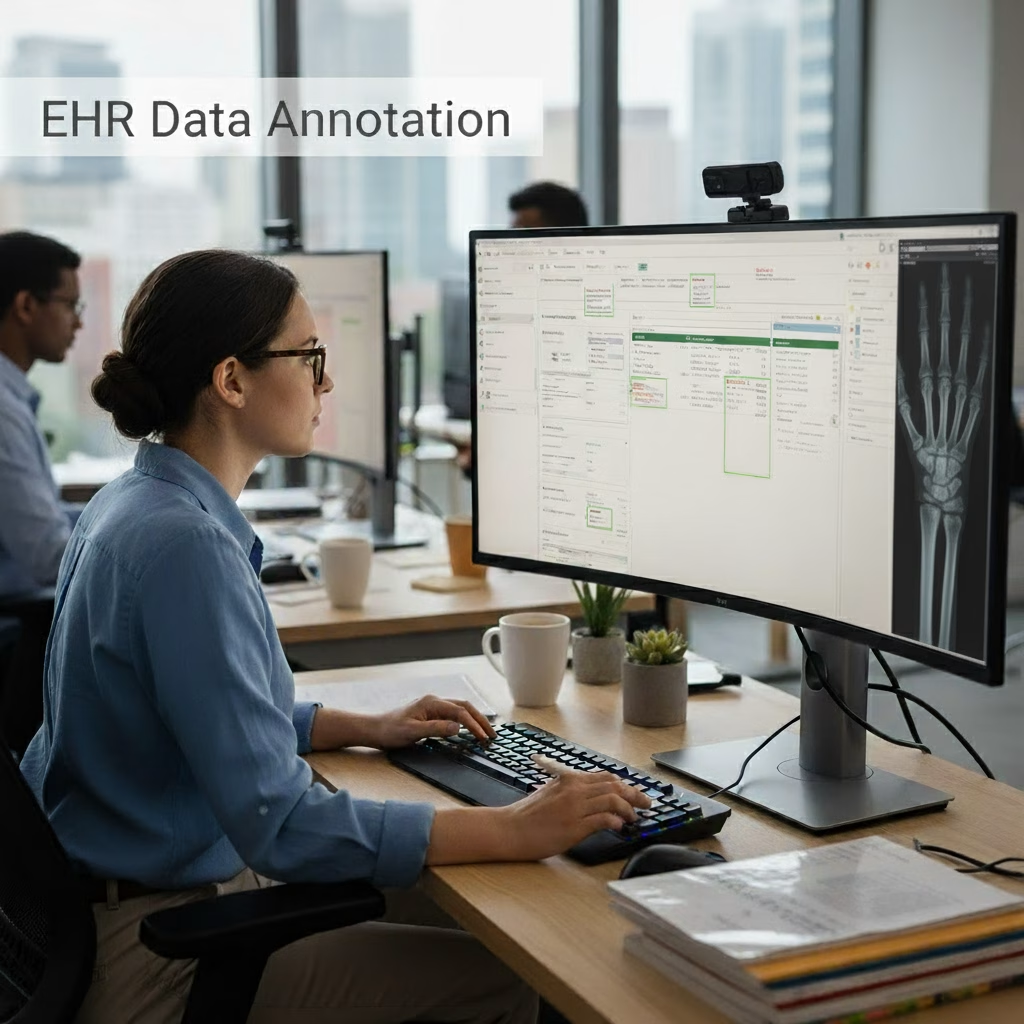
In today’s fast-paced healthcare industry, data is everywhere, streaming in from hospitals, clinics, and diagnostic centers in the form of diagnoses, test findings, prescriptions, imaging scans, and physicians’ notes. But here’s the catch: all of this raw data is like a box of gold without a key, full of value but impossible to open. This is where electronic health record (EHR) annotation comes in. EHR annotation transforms complex, unstructured data into clean, structured insights, enabling smarter decisions, faster treatments, and improved patient outcomes.
So, let’s dive into the world of EHR annotation and see how it’s shaping the future of healthcare.
Why Raw EHR Data is Not Enough
Imagine a hospital’s EHR system to be a large library. Patient records, lab data, and medical notes gather like books on a shelf. Without a clear system to organize and interpret it, finding the right information can be frustrating, or even impossible. Raw EHRs sometimes include free-text comments, misspellings, abbreviations, and inconsistent forms. AI models, predictive analytics, and healthcare apps struggle to make sense of such unstructured data. What are the consequences? Missed opportunities, delayed decision-making, and possible dangers to patient care.
The Magic of EHR Annotation
EHR annotation is the process of labeling, categorizing, and arranging healthcare data so that machines and, ultimately, healthcare professionals can use it efficiently. Imagine it as translating a foreign language into one that everyone understands. For example:
- Clinical notes can be annotated to help determine symptoms, diagnosis, and therapies.
- Lab reports might be labeled to indicate specific biomarkers or abnormal results.
- Annotating imaging data can help to identify areas of concern, such as tumors or fractures.
Once annotated, this information becomes actionable. Predictive models can detect disease symptoms before they become severe. Decision-support tools can recommend tailored treatment plans. Researchers can examine trends among thousands of patients. In essence, annotation transforms raw, unstructured data into a strategic asset.
The Potential Effect on Healthcare Outcomes
Annotated EHRs don’t just make life easier for data scientists. They also have a direct impact on patient outcomes:
- Improved Diagnostics: AI systems trained on annotated data can identify diabetic retinopathy, heart disease, and cancer with high accuracy.
- Personalized Treatment: Structured EHR data enables precision medicine, allowing clinicians to recommend treatments based on each patient’s individual profile.
- Predictive analytics: allows hospitals to forecast complications, readmissions, and disease outbreaks by using annotated datasets.
- Operational Efficiency: Annotated data allows healthcare providers to streamline workflows, reduce manual charting, and focus more on patient care.
In essence, annotation bridges the gap between information and insight, powering a smarter, faster, and safer healthcare system.
Challenges in EHR Annotation
- The huge amount of data: Every day, the healthcare industry produces huge amounts of patient data. Accurately managing and annotating this data is a major task.
- Precision Is Essential: Annotation errors may affect patient treatment or result in inaccurate insights. At every stage of the annotation process, accuracy is crucial.
- Complicated Medical Terminology: Medical notes often include terms that are context-dependent.
- Compliance and Privacy: Patient data is highly sensitive, ensuring annotations maintain privacy and regulatory compliance adds another layer of complexity.
- Context Matters: Understanding the full context of patient notes is crucial for accurate annotation. Misinterpreting context can lead to misleading data.
The Future of Healthcare With Annotated EHRs
This section can explore upcoming trends and innovations, such as:
- High-quality annotated data lowers bias in AI models, resulting in more equitable and reliable therapeutic recommendations.
- Annotated EHRs allow for personalized therapies, ranging from medicine selection to lifestyle suggestions.
- Smart device data can be integrated with annotated EHRs to give real-time monitoring of chronic conditions and early alerts.
- Structured datasets enable researchers to spot patterns, test hypotheses, and accelerate trials, reducing the time from lab to patient.
- Annotated EHRs make remote consultations more effective by providing clinicians with clear, structured patient histories.
Why Partnering With Experts Matters
Many healthcare practitioners use specialist annotation firms because of the risks and complexity involved. These partners bring a blend of medical knowledge, data science expertise, and scalable processes to handle large volumes of EHRs efficiently. This guarantees that the data is clean, formatted, and ready for quick use in AI models, predictive analytics, and clinical trials.
Medrays: Enabling Actionable Healthcare Insights
Among the industry leaders, Medrays stands out for its dedication to precision and quality in medical data annotation. Medrays turns raw EHRs into datasets that healthcare providers and AI models can rely on.
We ensures that every piece of data, whether it’s clinical notes, lab reports, or imaging data, is precisely labeled, consistent with standards, and ready to generate useful insights. Medrays’ expertise enables healthcare organizations to speed research, enhance patient outcomes, and confidently make data-driven decisions.
To Conclude
The journey from raw EHR data to meaningful insights is no longer an option- it’s essential. Proper annotation unlocks the full potential of healthcare data, enabling predictive analytics, personalized therapies, and better decision-making. While challenges persist, professional partners such as Medrays enable the conversion of vast, unorganized datasets into a powerful tool for improved patient outcomes and a healthier future.
